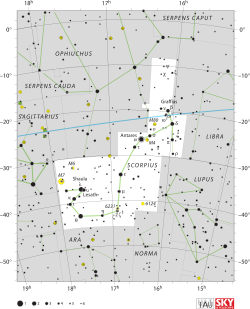HD 155448
| HD 155448 | |
 | |
| Observationsdata Epok: J2000.0 | |
|---|---|
| Stjärnbild | Skorpionen |
| Rektascension | 17t 12m 58,7680s[1] |
| Deklination | -32° 14′ 33,5690″[1] |
| Skenbar magnitud () | +8,72[2] |
| Stjärntyp | |
| Spektraltyp | B1 V[3] |
| B–V | -0,27 ± 0,02 |
| Astrometri | |
| Egenrörelse (µ) | RA: +2,551[4] mas/år Dek.: -1,666[4] mas/år |
| Parallax () | 0,9566 ± 0,0440[2] |
| Avstånd | 3 400 ± 200 lå (1 050 ± 50 pc) |
| Detaljer | |
| Massa | >7[5] M☉ |
| Temperatur | 25 000[6] K |
| Vinkelhastighet | 90 ± 5[5] km/s |
| Andra beteckningar | |
| HD 155448, CCDM J17130-3215A, CD-32 12461, CPD-32 4403, GSC 07365-00475, HD 155448A, HIC 84228, HIP 84228, 2MASS J17125876-3214335, PPM 296043, SAO 208540, TD1 20062, TYC 7365-475-1, UCAC4 289-119501, WDS J17130-3215A, Gaia DR3 5980305457968737280, Gaia DR2 5980305457968737280[3] | |
HD 155448 är en multipelstjärna i den norra delen av stjärnbilden Skorpionen. Den har en kombinerad skenbar magnitud av ca 8,72[2] och kräver en kraftig handkikare eller ett mindre teleskop för att kunna observeras. Baserat på parallax enligt Gaia Data Release 3 på ca 0,957 mas,[4] beräknas den befinna sig på ett avstånd på ca 3 400 ljusår (1 050 parsek) från solen.
Observation
[redigera | redigera wikitext]Parallaxmätningar 1997 av rymdsonden Hipparcos gav HD 155448 ett avstånd på 1 976 ljusår med en felmarginal som är större än själva parallaxen.[1] Den nya Hipparcos-reduktionen gav ett avstånd på 6 272 ljusår, men fortfarande med en statistisk felmarginal som är större än parallaxvärdet.[7] Gaia-parallaxer finns tillgängliga för de synliga komponenterna. För komponent C är parallaxerna Gaia Data Release 2 och Gaia Early Data Release 3 (EDR3) både negativa och något meningslösa.[8][9] För komponenterna A, B och D är Gaia EDR3-parallaxerna 0,9566 ± 0,0440 mas,[4] 0,8401 ± 0,0384 mas,[6] respektive 0,7837 ± 0,0263 mas[9], vilket ger ett avstånd av ca 4 000 ljusår.
Före 2011 misstogs denna stjärna som antingen en Herbig-Ae/Be-stjärna[10] eller ett post-AGB-objekt.[11] När systemet studerades 2011 antogs det ursprungligen bara innehålla fyra stjärnor (eller åtminstone mer än två stjärnor). År 2011 drog en studie utförd vid European Southern Observatory i Chile slutsatsen att "B"-stjärnan faktiskt är en dubbelstjärna, vilket omklassificerade HD 155448 till ett femdubblat stjärnsystem,[5] HD 155448 A, B, C och D. Perioder har uppskattats till 27 000 år för Bab, 59 000 år för AB, 111 000 år för Ac och 327 000 år för AD.[12] En analys 2011 visar dock att stjärnorna inte är gravitationsmässigt bundna till varandra.[5]
Alla stjärnor är för närvarande på ZAMS. För närvarande har primärstjärnan en massa som är större än 7 solmassor och en effektiv temperatur på 25 000 K, medan följeslagarna har massor som sträcker sig från 3-6 gånger solens massa och temperaturer från 10 000-16 000 K.
Referenser
[redigera | redigera wikitext]- Den här artikeln är helt eller delvis baserad på material från engelskspråkiga Wikipedia, HD 142990, 1 december 2023.
Noter
[redigera | redigera wikitext]- ^ [a b c] Perryman, M. A. C.; Lindegren, L.; Kovalevsky, J.; Hoeg, E.; Bastian, U.; Bernacca, P. L.; Crézé, M.; Donati, F.; Grenon, M.; Grewing, M.; van Leeuwen, F. (1997-07-01). "The HIPPARCOS Catalogue". Astronomy and Astrophysics. 323: L49–L52. Bibcode:1997A&A...323L..49P. ISSN 0004-6361.
- ^ [a b c] "HD 155448". sim-basic. Hämtad 21 mars 2021.
- ^ [a b] .HD 155448 (unistra.fr). Hämtad 2024-04-06.
- ^ [a b c d] Brown, A. G. A.; et al. (Gaia collaboration) (2021). "Gaia Early Data Release 3: Summary of the contents and survey properties". Astronomy & Astrophysics. 649: A1. arXiv:2012.01533. Bibcode:2021A&A...649A...1G. doi:10.1051/0004-6361/202039657. S2CID 227254300. (Erratum: doi:10.1051/0004-6361/202039657e). Gaia EDR3 record for this source at VizieR.
- ^ [a b c d] Schütz, O.; Meeus, G.; Carmona, A.; Juhász, A.; Sterzik, M. F. (2011-09-01). "The young B-star quintuple system HD 155448". Astronomy and Astrophysics. 533: A54. arXiv:1108.1557. Bibcode:2011A&A...533A..54S. doi:10.1051/0004-6361/201016396. ISSN 0004-6361.
- ^ [a b] Brown, A. G. A.; et al. (Gaia collaboration) (2021). "Gaia Early Data Release 3: Summary of the contents and survey properties". Astronomy & Astrophysics. 649: A1. arXiv:2012.01533. Bibcode:2021A&A...649A...1G. doi:10.1051/0004-6361/202039657. S2CID 227254300. (Erratum: doi:10.1051/0004-6361/202039657e). Gaia EDR3 record for this source at VizieR.
- ^ van Leeuwen, F. (November 2007). "Validation of the new Hipparcos reduction". Astronomy & Astrophysics. 474 (2): 653–664. arXiv:0708.1752. Bibcode:2007A&A...474..653V. doi:10.1051/0004-6361:20078357. ISSN 1432-0746.
- ^ Brown, A. G. A.; et al. (Gaia collaboration) (August 2018). "Gaia Data Release 2: Summary of the contents and survey properties". Astronomy & Astrophysics. 616. A1. arXiv:1804.09365. Bibcode:2018A&A...616A...1G. doi:10.1051/0004-6361/201833051. Gaia DR2 record for this source at VizieR.
- ^ [a b] Brown, A. G. A.; et al. (Gaia collaboration) (2021). "Gaia Early Data Release 3: Summary of the contents and survey properties". Astronomy & Astrophysics. 649: A1. arXiv:2012.01533. Bibcode:2021A&A...649A...1G. doi:10.1051/0004-6361/202039657. S2CID 227254300. (Erratum: doi:10.1051/0004-6361/202039657e). Gaia EDR3 record for this source at VizieR.
- ^ Vioque, M.; Oudmaijer, R. D.; Baines, D.; Mendigutía, I.; Pérez-Martínez, R. (December 2018). "Gaia DR2 study of Herbig Ae/Be stars". Astronomy & Astrophysics. 620: A128. arXiv:1808.00476. Bibcode:2018A&A...620A.128V. doi:10.1051/0004-6361/201832870. ISSN 1432-0746.
- ^ Luna, R.; Cox, N. L. J.; Satorre, M. A.; García Hernández, D. A.; Suárez, O.; García Lario, P. (March 2008). "A search for diffuse bands in the circumstellar envelopes of post-AGB stars". Astronomy & Astrophysics. 480 (1): 133–148. arXiv:0711.1843. Bibcode:2008A&A...480..133L. doi:10.1051/0004-6361:20065282. ISSN 1432-0746.
- ^ Tokovinin, Andrei (2018-03-01). "The Updated Multiple Star Catalog". The Astrophysical Journal Supplement Series. 235 (1): 6. arXiv:1712.04750. Bibcode:2018ApJS..235....6T. doi:10.3847/1538-4365/aaa1a5. ISSN 0067-0049. S2CID 119047709.
Externa länkar
[redigera | redigera wikitext]Text is available under the CC BY-SA 4.0 license; additional terms may apply.
Images, videos and audio are available under their respective licenses.



